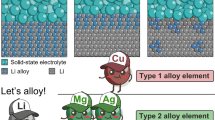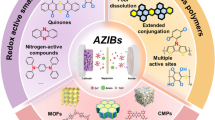Abstract
With the permeation of LIBs into electric vehicles, the recycling of spent LIBs appears inevitable from the perspective of health, economic, and environmental protection. In this work, a facile process was proposed to realize the recycling and reutilization of valuable metals from spent LIBs. By ammonia leaching, co-precipitation, and solid phase reaction, fresh LiNi0.6Co0.2Mn0.2O2 cathode material was regenerated. The results revealed that an increase in the concentration of sulfite and ammonia was beneficial to the dissolution of valuable metals except aluminum. And the dissolution of Mn was mainly dominated by pH value and the concentration of sulfite. The initial specific discharge capacity of the regenerated LiNi0.6Co0.2Mn0.2O2 reaches 178.4 mAh·g−1 at 0.1 C. After 100 cycles, the capacity retains 92.1% at 0.5 C, which shows excellent electrochemical performance. In general, the recycling process may be worth considering for the recycling of spent lithium-ion batteries.








Similar content being viewed by others
References
Yu M, Zhang Z, Xue F et al (2019) A more simple and efficient process for recovery of cobalt and lithium from spent lithium-ion batteries with citric acid. Sep Purif Technol 215:398–402. https://doi.org/10.1016/j.seppur.2019.01.027
Kang DHP, Chen M, Ogunseitan OA (2013) Potential environmental and human health impacts of rechargeable lithium batteries in electronic waste. Environ Sci Technol 47:5495–5503. https://doi.org/10.1021/es400614y
Zeng X, Li J, Liu L (2015) Solving spent lithium-ion battery problems in China: opportunities and challenges. Renew Sustain Energy Rev 52:1759–1767. https://doi.org/10.1016/j.rser.2015.08.014
Peng C, Liu F, Wang Z et al (2019) Selective extraction of lithium (Li) and preparation of battery grade lithium carbonate (Li2CO3) from spent Li-ion batteries in nitrate system. J Power Sources 415:179–188. https://doi.org/10.1016/j.jpowsour.2019.01.072
Yue LP, Lou P, Xu GH et al (2020) Regeneration of degraded LiNi0.5Co0.2Mn0.3O2 from spent lithium ion batteries. Ionics (Kiel) 26:2757–2761. https://doi.org/10.1007/s11581-020-03479-8
Sun L, Qiu K (2012) Organic oxalate as leachant and precipitant for the recovery of valuable metals from spent lithium-ion batteries. Waste Manag 32:1575–1582. https://doi.org/10.1016/j.wasman.2012.03.027
Zeng X, Li J, Singh N (2014) Recycling of spent lithium-ion battery: a critical review. Crit Rev Environ Sci Technol 44:1129–1165. https://doi.org/10.1080/10643389.2013.763578
Zheng X, Zhu Z, Lin X et al (2018) A mini-review on metal recycling from spent lithium ion batteries. Engineering 4:361–370. https://doi.org/10.1016/j.eng.2018.05.018
Boxall NJ, Cheng KY, Bruckard W, Kaksonen AH (2018) Application of indirect non-contact bioleaching for extracting metals from waste lithium-ion batteries. J Hazard Mater 360:504–511. https://doi.org/10.1016/j.jhazmat.2018.08.024
Dutta D, Kumari A, Panda R et al (2018) Close loop separation process for the recovery of Co, Cu, Mn, Fe and Li from spent lithium-ion batteries. Sep Purif Technol 200:327–334. https://doi.org/10.1016/j.seppur.2018.02.022
Liu C, Lin J, Cao H et al (2019) Recycling of spent lithium-ion batteries in view of lithium recovery: a critical review. J Clean Prod 228:801–813. https://doi.org/10.1016/j.jclepro.2019.04.304
Gaines L (2014) The future of automotive lithium-ion battery recycling: charting a sustainable course. Sustain Mater Technol 1:2–7. https://doi.org/10.1016/j.susmat.2014.10.001
Chen X, Chen Y, Zhou T et al (2015) Hydrometallurgical recovery of metal values from sulfuric acid leaching liquor of spent lithium-ion batteries. Waste Manag 38:349–356. https://doi.org/10.1016/j.wasman.2014.12.023
Asadi Dalini E, Karimi G, Zandevakili S, Goodarzi M (2020) A review on environmental, economic and hydrometallurgical processes of recycling spent lithium-ion batteries. Miner Process Extr Metall Rev 00:1–22. https://doi.org/10.1080/08827508.2020.1781628
Barik SP, Prabaharan G, Kumar L (2017) Leaching and separation of Co and Mn from electrode materials of spent lithium-ion batteries using hydrochloric acid: laboratory and pilot scale study. J Clean Prod 147:37–43. https://doi.org/10.1016/j.jclepro.2017.01.095
Swain B, Jeong J, Lee J-C et al (2007) Hydrometallurgical process for recovery of cobalt from waste cathodic active material generated during manufacturing of lithium ion batteries. J Power Sources 167:536–544. https://doi.org/10.1016/j.jpowsour.2007.02.046
Hu J, Zhang J, Li H et al (2017) A promising approach for the recovery of high value-added metals from spent lithium-ion batteries. J Power Sources 351:192–199. https://doi.org/10.1016/j.jpowsour.2017.03.093
Dorella G, Mansur MB (2007) A study of the separation of cobalt from spent Li-ion battery residues. J Power Sources 170:210–215. https://doi.org/10.1016/j.jpowsour.2007.04.025
Zhang J, Hu J, Zhang W et al (2018) Efficient and economical recovery of lithium, cobalt, nickel, manganese from cathode scrap of spent lithium-ion batteries. J Clean Prod 204:437–446. https://doi.org/10.1016/j.jclepro.2018.09.033
Yuliusman, Fajaryanto R, Nurqomariah A, Silvia (2018) Acid leaching and kinetics study of cobalt recovery from spent lithium-ion batteries with nitric acid. E3S Web Conf 67:1–5. https://doi.org/10.1051/e3sconf/20186703025
Chen X, Ma H, Luo C, Zhou T (2017) Recovery of valuable metals from waste cathode materials of spent lithium-ion batteries using mild phosphoric acid. J Hazard Mater 326:77–86. https://doi.org/10.1016/j.jhazmat.2016.12.021
Setiawan H, Petrus HTBM, Perdana I (2019) Reaction kinetics modeling for lithium and cobalt recovery from spent lithium-ion batteries using acetic acid. Int J Miner Metall Mater 26:98–107. https://doi.org/10.1007/s12613-019-1713-0
Gao W, Zhang X, Zheng X et al (2017) Lithium carbonate recovery from cathode scrap of spent lithium-ion battery: a closed-loop process. Environ Sci Technol 51:1662–1669. https://doi.org/10.1021/acs.est.6b03320
de Oliveira Demarco J, StefanelloCadore J, da Silveira de Oliveira F et al (2019) Recovery of metals from spent lithium-ion batteries using organic acids. Hydrometallurgy 190:105169. https://doi.org/10.1016/j.hydromet.2019.105169
Li L, Zhai L, Zhang X et al (2014) Recovery of valuable metals from spent lithium-ion batteries by ultrasonic-assisted leaching process. J Power Sources 262:380–385. https://doi.org/10.1016/j.jpowsour.2014.04.013
Yang YQ, Wang CY, Li DF et al (2011) Study on the leaching of LiCoO2 in low H2SO4 concentration solutions. Adv Mater Res 201–203:1752–1756. https://doi.org/10.4028/www.scientific.net/AMR.201-203.1752
Vieceli N, Nogueira CA, Guimarães C et al (2018) Hydrometallurgical recycling of lithium-ion batteries by reductive leaching with sodium metabisulphite. Waste Manag 71:350–361. https://doi.org/10.1016/j.wasman.2017.09.032
Wang S, Wang C, Lai F et al (2020) Reduction-ammoniacal leaching to recycle lithium, cobalt, and nickel from spent lithium-ion batteries with a hydrothermal method: effect of reductants and ammonium salts. Waste Manag 102:122–130. https://doi.org/10.1016/j.wasman.2019.10.017
Chander S, Sharma VN (1981) Reduction roasting/ammonia leaching of nickeliferous laterites. Hydrometallurgy 7:315–327. https://doi.org/10.1016/0304-386X(81)90029-3
Jeon SH, Yoo K, Alorro RD (2017) Separation of Sn, Bi, Cu from Pb-free solder paste by ammonia leaching followed by hydrochloric acid leaching. Hydrometallurgy 169:26–30. https://doi.org/10.1016/j.hydromet.2016.12.004
Li J, Chen Z, Shen B et al (2017) The extraction of valuable metals and phase transformation and formation mechanism in roasting-water leaching process of laterite with ammonium sulfate. J Clean Prod 140:1148–1155. https://doi.org/10.1016/j.jclepro.2016.10.050
Wang C, Wang S, Yan F et al (2020) Recycling of spent lithium-ion batteries: selective ammonia leaching of valuable metals and simultaneous synthesis of high-purity manganese carbonate. Waste Manag 114:253–262. https://doi.org/10.1016/j.wasman.2020.07.008
Ku H, Jung Y, Jo M et al (2016) Recycling of spent lithium-ion battery cathode materials by ammoniacal leaching. J Hazard Mater 313:138–146. https://doi.org/10.1016/j.jhazmat.2016.03.062
Shaju KM, Subba Rao GV, Chowdari BVR (2002) Performance of layered Li(Ni1/3Co1/3Mn1/3)O2 as cathode for Li-ion batteries. Electrochim Acta 48:145–151. https://doi.org/10.1016/S0013-4686(02)00593-5
Wu F, Tian J, Su Y et al (2015) Effect of Ni2+ content on lithium/nickel disorder for Ni-rich cathode materials. ACS Appl Mater Interfaces 7:7702–7708. https://doi.org/10.1021/acsami.5b00645
Meng X, Han KN (1996) Principles and applications of ammonia leaching of metals—a review. Miner Process Extr Metall Rev 16:23–61. https://doi.org/10.1080/08827509608914128
Zuniga M, Parada LF, Asselin E (2010) Leaching of a limonitic laterite in ammoniacal solutions with metallic iron. Hydrometallurgy 104:260–267. https://doi.org/10.1016/j.hydromet.2010.06.014
Chen Y, Liu N, Hu F et al (2018) Thermal treatment and ammoniacal leaching for the recovery of valuable metals from spent lithium-ion batteries. Waste Manag 75:469–476. https://doi.org/10.1016/j.wasman.2018.02.024
Golmohammadzadeh R, Faraji F, Rashchi F (2018) Recovery of lithium and cobalt from spent lithium ion batteries (LIBs) using organic acids as leaching reagents: a review. Resour Conserv Recycl 136:418–435. https://doi.org/10.1016/j.resconrec.2018.04.024
Takeno N (2005) Atlas of Eh-pH diagrams intercomparison of thermodynamic databases. Natl Inst Adv Ind Sci Technol, Tokyo, pp. 145–147
Wang RT, Tai EG, Chen JY et al (2019) A KMnF3 perovskite structure with improved stability, low bandgap and high transport properties. Ceram Int 45:64–68. https://doi.org/10.1016/j.ceramint.2018.09.134
Santhanam R, Jones P, Sumana A et al (2010) Influence of lithium content on high rate cycleability of layered Li1+xNi0.30Co0.30Mn0.40O2 cathodes for high power lithium-ion batteries. J Power Sources 195:7391–7396. https://doi.org/10.1016/j.jpowsour.2010.06.004
Xia Y, Nie M, Wang Z et al (2015) Structural, morphological and electrochemical investigation sintering conditions. Ceram Int 41:11815–11823. https://doi.org/10.1016/j.ceramint.2015.05.150
Shang M, Peng L (2021) The regeneration and electrochemical performance study of NCM622 cathode materials. Ionics (Kiel) 27:527–532. https://doi.org/10.1007/s11581-020-03861-6
Yang X, Dong P, Hao T et al (2020) A combined method of leaching and co-precipitation for recycling spent LiNi0.6Co0.2Mn0.2O2 cathode materials: process optimization and performance aspects. Jom 72:3843–3852. https://doi.org/10.1007/s11837-020-04263-9
Fei Z, Meng Q, Dong P et al (2021) Preparation of cathode materials by spray drying from leaching solution of spent lithium-ion batteries materials. Int J Electrochem Sci 16:1–10. https://doi.org/10.20964/2021.03.17
Author information
Authors and Affiliations
Corresponding author
Additional information
Publisher's note
Springer Nature remains neutral with regard to jurisdictional claims in published maps and institutional affiliations.
Supplementary Information
Below is the link to the electronic supplementary material.
Rights and permissions
About this article
Cite this article
Zhu, J., Guo, G., Wu, J. et al. Recycling and reutilization of LiNi0.6Co0.2Mn0.2O2 cathode materials from spent lithium-ion battery. Ionics 28, 241–250 (2022). https://doi.org/10.1007/s11581-021-04308-2
Received:
Revised:
Accepted:
Published:
Issue Date:
DOI: https://doi.org/10.1007/s11581-021-04308-2




